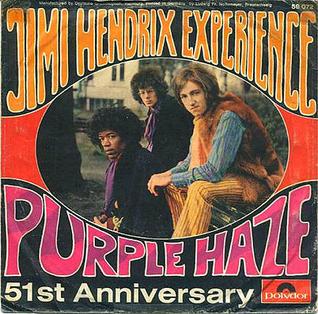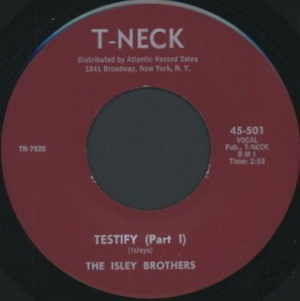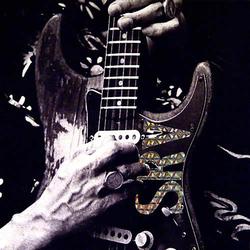
James Marshall "Jimi" Hendrix was an American guitarist, songwriter and singer. Although his mainstream career spanned only four years, he is widely regarded as the greatest and one of the most influential electric guitarists in the history of popular music, and one of the most celebrated musicians of the 20th century. The Rock and Roll Hall of Fame describes him as "arguably the greatest instrumentalist in the history of rock music."

Electric Ladyland is the third and final studio album by the Jimi Hendrix Experience, released in October 1968. A double album, it was the only record from the Experience with production solely credited to Hendrix. The band's most commercially successful release and its only number one album, it was released by Reprise Records in the United States on October 16, 1968, and by Track Records in the UK nine days later. By mid-November, it had reached number 1 on the Billboard Top LPs chart, spending two weeks there. In the UK it peaked at number 6, where it spent 12 weeks on the British charts.

"Purple Haze" is a song written by Jimi Hendrix and released as the second single by the Jimi Hendrix Experience on March 17, 1967, in the United Kingdom. The song features his inventive guitar playing, which uses the signature Hendrix chord and a mix of blues and Eastern modalities, shaped by novel sound processing techniques. Because of ambiguities in the lyrics, listeners often interpret the song as referring to a psychedelic experience, although Hendrix described it as a love song. It was included as the opening track in the North American edition of the Experience's debut album, Are You Experienced (1967).

Axis: Bold as Love is the second studio album by the Jimi Hendrix Experience. It was first released by Track Records in the United Kingdom on December 1, 1967, only seven months after the release of the group's highly successful debut album, Are You Experienced. In the United States, Reprise Records delayed the release until the following month. The album reached the top ten in the album charts in both countries.
"Little Wing" is a song written by Jimi Hendrix and recorded by the Jimi Hendrix Experience in 1967. It is a slower tempo, rhythm and blues-inspired ballad featuring Hendrix's vocal and guitar with recording studio effects accompanied by bass, drums, and glockenspiel. Lyrically, it is one of several of his songs that reference an idealized feminine or guardian angel-like figure. At about two and a half minutes in length, it is one of his most concise and melodically focused pieces.
"Six Strings Down" is a blues song recorded by Jimmie Vaughan in 1994. It is a tribute to his brother, Stevie Ray Vaughan, who died in 1990, and the memory of other deceased guitarists. The song was written by Art Neville, Eric Kolb, Aaron Neville, Cyril Neville, Kelsey Smith, and Vaughan. It first appeared on Vaughan's album Strange Pleasure, in 1994.

Band of Gypsys is a live album by Jimi Hendrix and the first without his original group, the Jimi Hendrix Experience. It was recorded on January 1, 1970, at the Fillmore East in New York City with Billy Cox on bass and Buddy Miles on drums, frequently referred to as the Band of Gypsys. The album mixes funk and rhythm and blues elements with hard rock and jamming, an approach which later became the basis of funk rock. It contains previously unreleased songs and was the last full-length Hendrix album released before his death six months later.

First Rays of the New Rising Sun is a compilation album credited to American rock musician Jimi Hendrix, issued in April 1997 on MCA Records. Featuring songs mostly intended for his planned fourth studio album, it was one of the first releases overseen by Experience Hendrix, the family company that took over management of his recording legacy. It reached the album charts in the United States, United Kingdom, and four other countries.

Blues is a compilation album of blues songs recorded by American singer/songwriter/musician Jimi Hendrix. Compiled by interim Hendrix producer Alan Douglas, it was released April 26, 1994, by MCA Records. The album contains eleven songs recorded by Hendrix between 1966 and 1970, six of which were previously unreleased. Hendrix wrote seven of the pieces; other writers include Muddy Waters, Booker T. Jones, and Elmore James. Most are demos, jams, and live recordings, which Hendrix may or may not have completed for release.

The Ultimate Experience is a 1992 compilation album of songs by American musician Jimi Hendrix. It includes 20 tracks spanning his career. The album was among the last to be supervised by interim producer Alan Douglas, before the Hendrix family regained control of his recording legacy. It has gone out-of-print and, in 1997, was replaced by the 20 track compilation Experience Hendrix: The Best of Jimi Hendrix.
"Voodoo Chile" is a song written by Jimi Hendrix and recorded in 1968 for the third Jimi Hendrix Experience album Electric Ladyland. It is based on the Muddy Waters blues song "Rollin' Stone", but with original lyrics and music. At 15 minutes, it is Hendrix's longest studio recording and features additional musicians in what has been described as a studio jam.

Kiss the Sky is a compilation album by American rock guitarist, singer–songwriter Jimi Hendrix. In the US, it was released by Reprise Records in October 1984 and by Polydor Records in the UK in November 1984. The album's title is taken from the lyrics of "Purple Haze."

"Testify" is an uptempo soul song by the American rhythm and blues group the Isley Brothers. Written by the Isleys and recorded in 1964, it followed several successful singles by the group and was the first single to appear on their own T-Neck record label.
"Third Stone from the Sun" is a mostly instrumental composition by American musician Jimi Hendrix. It incorporates several musical approaches, including jazz and psychedelic rock, with brief spoken passages. The title reflects Hendrix's interest in science fiction and is a reference to Earth in its position as the third planet away from the sun in the solar system.
"1983… " is a song recorded in 1968 for the third studio album, Electric Ladyland, by the Jimi Hendrix Experience. Written and produced by Jimi Hendrix, the song features flute player Chris Wood of the band Traffic, and at over 13 minutes in duration is the second longest track released by the group.
"Come On" is a song written by New Orleans rhythm and blues artist Earl King. He first recorded the song as "Darling Honey Angel Child" in 1960 for the Ace Records subsidiary Rex. Later that year, he recorded it as a two-part song for Imperial Records using some new lyrics. Retitled "Come On", it was released in 1960 with "Come On – Part I” as the A-side backed with “Come On – Part II”.

Cornerstones 1967–1970 is a 1990 compilation album by American guitarist Jimi Hendrix. It features 18 of his greatest hits, including live renditions of "Fire" and "Stone Free" from the Atlanta International Pop Festival, Byron, Georgia, July 4, 1970. It was released on the Polydor label in the United Kingdom and other parts of Europe. The album entered the UK Albums Chart in November 1990 at No. 5, its highest position during a sixteen-week stay in the chart. All songs were recorded between October 23, 1966, and August 1970. This was the only compact disc release at the time to have the studio version of "The Star Spangled Banner".

The Real Deal: Greatest Hits, Volume 2 is a compilation album of material by Stevie Ray Vaughan in 1999. The album was released by Epic Records and includes material from the five studio albums he released with Double Trouble as well as live material and collaborations with brother Jimmie and surf guitarist Dick Dale.

"Hear My Train A Comin'" is a blues-based song written by Jimi Hendrix. Lyrically, it was inspired by earlier American spirituals and blues songs which use a train metaphor to represent salvation. Hendrix recorded the song in live, studio, and impromptu settings several times between 1967 and 1970, but never completed it to his satisfaction.












